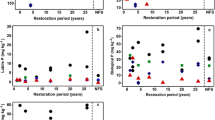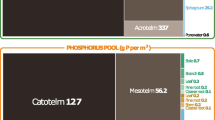Abstract
Aims
To test predictions of ecosystem theory for changes in P cycling over primary succession, we determined soil phosphorus (P) in labile, primary mineral, organic, and occluded forms along a chronosequence of five wave cut terraces known as the “Ecological Staircase”. The Ecological Staircase terraces (T1-T5) transition naturally from fertile native coastal forests in California, USA, to diminutive pygmy vegetation over the span of > 500,000 years of pedogenesis.
Methods
Soil P fractions were quantified to a depth of 40 cm on T1-T5 using a modified Hedley P fractionation procedure.
Results
Overall results confirmed the Walker and Syers Model of Phosphorus Transformations During Pedogenesis: total P declined from youngest (194 mg/kg P) to oldest (127 mg/kg P) sites; primary-mineral P decreased sharply from T1 to older sites; and occluded P dominated P pools at the oldest pygmy sites (T3-T5). In addition, foliar P concentrations declined markedly in the pygmy forest, and N/P of vegetation (T1: 6.03, T5: 14.4) and N/Porganic of mineral soils (T1: 6.10, T5: 25.3) increased significantly over time.
Conclusions
Results point to P as the primary limiting nutrient in the pygmy forest, exemplifying the terminal steady-state of ecosystem retrogression that underlies the persistence of this unique ecosystem.




Similar content being viewed by others
References
Aerts R, Chapin FS III (2000) The mineral nutrition of wild plants revisited: A Re-evaluation of processes and patterns. Adv Ecol Res 30:1–67
Chadwick OA, Derry LA, Vitousek PM, Huebert BJ, Hedin LO (1999) Changing sources of nutrients during four mullion years of ecosystem development. Nature 397:491–497
Craine CM, Morrow C, Stock WD (2008) Nutrient concentration ratios and co-limitation in South African grasslands. New Phyto 179:829–836
Crews TE, Kitayama K, Fownes JH, Riley RH, Herbert DA, Mueller-Dombois D, Vitousek PM (1995) Changes in soil phosphorus and ecosystem dynamics across a long chronosequence in Hawaii. Ecology 76:1407–1424
Dose J 2004 City of Fort Bragg Inflow and Infiltration Repair Project. U.S. Environmental Protection Agency.
Duce RA, Tindale NW (1991) Atmospheric transport of iron and its deposition in the ocean. Limnol Oceanogr 36:1715–1726
Elser JJ, Bracken MES, Cleland EE, Gruner DS, Harpole WS, Hillebrand H, Ngai JT, Seabloom EW, Shurin JB, Smith JE (2007) Global analysis of nitrogen and phosphorus limitation of primary producers in freshwater, marine, and terrestrial, ecosystems. Ecol Lett 10:1–8
Gusewell S, Koerselman W, Verhoeven JTA (2003) Biomass N:P ratios as indicators of nutrient limitation for plant populations in wetlands. Ecol Appl 13(2):372–384
Handley WRC (1961) Further evidence for the importance of residual leaf protein complexes in litter decomposition and the supply of nitrogen for plant growth. Plant Soil 15(1):37–73
Hedley MJ, Stewart JWB, Chauhan BS (1982) Changes in Inorganic and Organic Soil Phosphorus Fractions induced by Cultivation Practices and by Laboratory Incubations. Soil Sci Soc Am J 46:970–976
Jackson ML, Levelt TWM, Syers JK, Rex RW, Clayton RN, Sherman GD, Uehara G (1971) Geomorphological relationships of tropospherically derived quartz in the soils of the Hawaiian Islands. Soil Sci Soc Am Proc 35:515–525
Jenny H, Arkley RJ, Schultz AM (1969) The pygmy forest-Podsol Ecosystem and its Dune Associates of the Mendocino Coast. Madroño 20:60–74
McGroddy ME, Daufresne T, Hedin LO (2004) Scaling of C:N:P Stoichiometry in Forests Worldwide: Implications of Terrestrial Redfield-type Ratios. Ecology 85(9):2390–2401
Northup RR, Dahlgren RA, Yu Z (1995) Intraspecific variation of conifer phenolic concentration on a marine terrace soil acidity gradient: a new interpretation. Plant Soil 171:255–262
Northup RR, Dahlgren RA, McColl JG (1998) Polyphenols as regulators of plant-litter-soil interactions in northern California’s pygmy forest: A positive feedback? Biogeochem 42:189–220
Parfitt RL, Ross DJ, Coomes DA, Richardson SJ, Smale MC, Dahlgren RA (2005) N and P in New Zealand Soil Chronosequences and Relationships with Foliar N and P. Biogeochem 75:305–328
Pearson HL, Vitousek PM (2002) Soil phosphorus fractions and symbiotic nitrogen fixation across a substrate-age gradient in Hawaii. Ecosystems 5:587–596
Peltzer DA, Wardle DA, Allison VJ, Biasden WT, Bardgett RD, Chadwick OA, Condron LM, Parfitt RL, Porder S, Richardson SJ, Turner BL, Vitousek PM, Walker J, Walker LR (2010) Understanding ecosystem retrogression. Ecol Monogr 80(4):509–529
Porder S, Vitousek PM, Chadwick OA, Chamberlain CP, Hilley GE (2007) Uplift, erosion, and phosphorus limitation in terrestrial ecosystems. Ecosystems 10:158–170
Reich PB, Oleksyn J (2004) Global patterns of plant leaf N and P in relation to temperature and latitude. Proc Natl Acad Sci 101:11001–11006
Richardson SJ, Peltzer DA, Allen RB, McGlone MS, Parfitt RL (2004) Rapid development of phosphorus limitation in temperate rainforest along the Franz Josef soil chronosequence. Oecologia 139:267–276
Tessier JT, Raynal DJ (2003) Use of nitrogen to phosphorus ratios in plant tissue as an indicator of nutrient limitation and nitrogen saturation. J Appl Ecol 40:523–534
Tiessen H, Moir JO (1993) Characterization of Available P by Sequential Extraction. In: Carter MR, Gregorich EG (eds) Soil Sampling and Methods of Analysis, 2nd edn. Taylor and Francis Group, Boca Raton, FL, pp 293–306
Tiessen H, Stewart JWB, Cole CV (1984) Pathways of phosphorus transformations in soils of differing pedogenesis. Soil Sci Soc Am J 48(4):853–858
Tiessen H, Cuevas E, Chacon P (1994) The role of soil organic matter in sustaining soil fertility. Nature 371:783–785
Townsend AR, Cleveland CC, Asner GP, Bustamante MMC (2007) Controls over foliar N:P ratios in tropical forests. Ecology 88(1):107–118
Turner B L, Lambers H, condron L M, Cramer M D, Leake K R, Richardson A E, and Smith S E 2012 Soil microbial biomass and the fate of phosphorus during long-term ecosystem development. Plant Soil November 2012
Turner BL, Wells A, Andersen KM, Condron LM (2012b) Paterns of tree community composition along a coastal dune chronosequence in lowland temperate rain forest in New Zealand. Plant Ecol 213:1525–1541
Vitousek PM (1984) Litterfall, nutrient cycling, and nutrient limitation in tropical forests. Ecology 65:285–298
Vitousek P 2004 Nutrient Cycling and Limitation: Hawai’I as a Model System. Princeton University Press.
Vitousek PM, Farrington H (1997) Nutrient limitation and soil development: Experimental test of a biogeochemical theory. Biogeochem 37:63–75
Vitousek PM, Howarth RW (1991) Nitrogen limitation on land and in the sea: How can it occur? Biogeochem 13(2):87–115
Vitousek PM, Porder S, Houlton BZ, Chadwick OA (2010) Terrestrial phosphorus limitation: mechanisms, implications, and nitrogen-phosphorus interactions. Ecol Appl 20(1):5–15
Walker TW, Syers JK (1976) The fate of phosphorus during pedogenesis. Geoderma 15:1–19
Wardle DA, Walker LR, Bardgett RD (2004) Ecosystem Properties and Forest Decline in Contrasting Long-Term Chronosequences. Science 305:509–513
Westman WE, Whittaker RH (1975) The pygmy forest region of northern California: Studies on biomass and primary productivity. J Ecol 63:493–520
Yu Z, Dahlgren RA, Northup RR (1999) Evolution of soil properties and plant communities along an extreme edaphic gradient. Eur J Soil Biol 35(1):31–38
Yu Z, Kraus TEC, Dahlgren RA, Horwath WR, Zasoski RJ (2003) Mineral and dissolved organic nitrogen dynamics along a soil acidity-fertility gradient. Soil Sci Soc Am J 67:878–888
Acknowledgments
This work was supported by grants to Professor Benjamin Z. Houlton from the Andrew W. Mellon Foundation and the Kearney Foundation of Soil Science. We would like to thank Dr. Randal Southard and Dr. Kate Scow from the Department of Land, Air, and Water Resources at UC Davis, for reviewing and editing early versions of this manuscript.
Author information
Authors and Affiliations
Corresponding authors
Additional information
Responsible Editor: Benjamin L. Turner.
Rights and permissions
About this article
Cite this article
Izquierdo, J.E., Houlton, B.Z. & van Huysen, T.L. Evidence for progressive phosphorus limitation over long-term ecosystem development: Examination of a biogeochemical paradigm. Plant Soil 367, 135–147 (2013). https://doi.org/10.1007/s11104-013-1683-3
Received:
Accepted:
Published:
Issue Date:
DOI: https://doi.org/10.1007/s11104-013-1683-3




